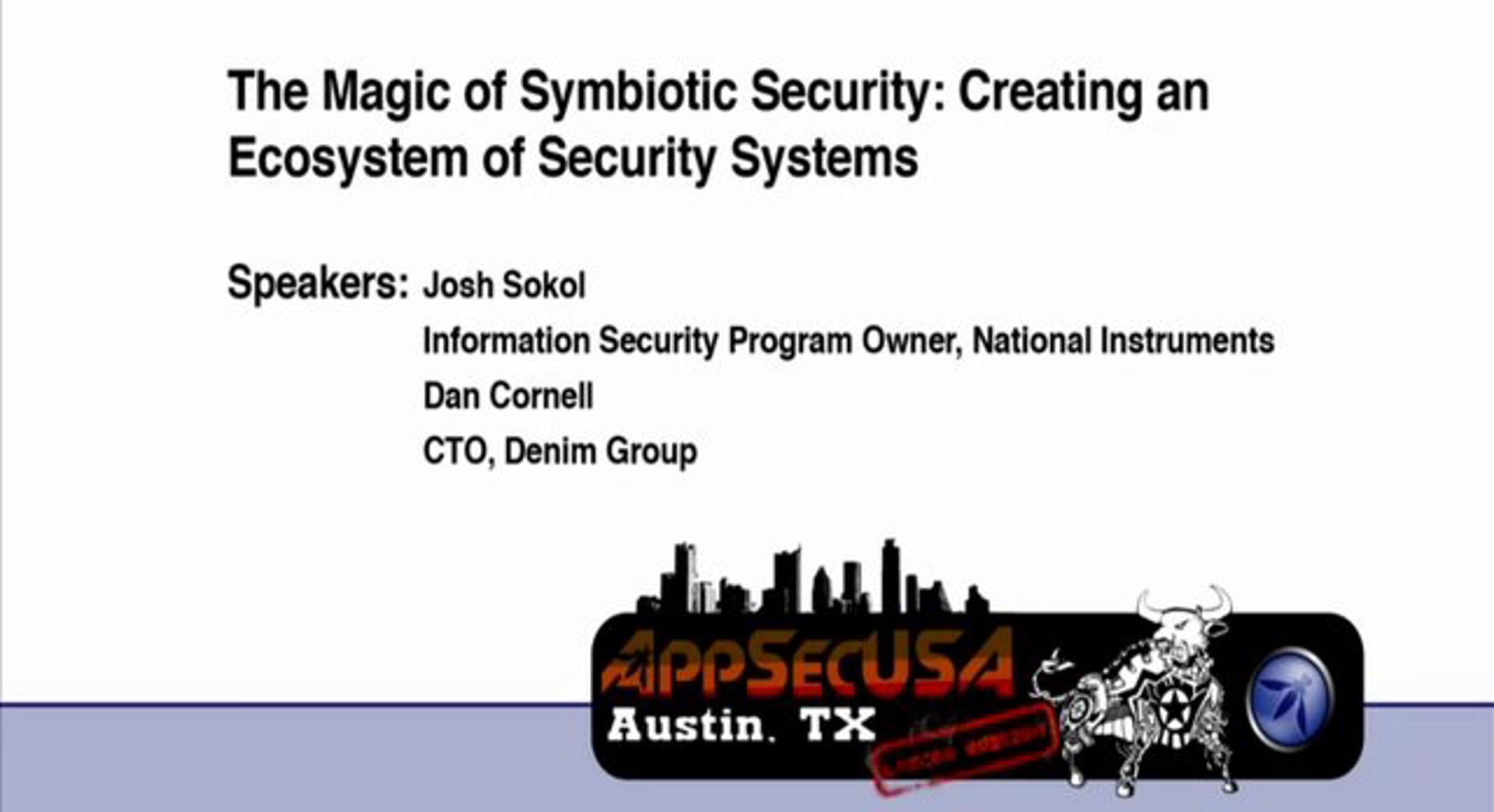The Magic of Symbiotic Security: Creating an Ecosystem of Security Systems – Dan Cornell and Josh Sokol
TTS
Title: The Magic of Symbiotic Security: Creating an Ecosystem of Security Systems
Abstract
Throw out everything that you know about security tools today. No more six-figure appliances that only do one thing marginally well. No more proprietary protocols. We deserve better and we demand better. Envision a world where your security tools talk with eachother. They communicate and share data in order to leverage eachothers strengths and and help compensate for their weaknesses. They work together to solve problems. Envision "Symbiotic Security".
Symbiotic Security is a new term that was coined to describe the ability of a tool to consume data from other tools or provide data to other tools. As part of our research, we have examined various classes of tools on the market and identified these abilities in each of them resulting in a label of "Consumer", "Provider", or "Symbiotic". As a consumer of security tools, this completely revolutionizes the way that we make purchases.
As an example, let's pretend that you are purchasing a new Intrusion Prevention System for your enterprise. As you begin to evaluate the various tools from the Gartner Magic Quadrant, you quickly realize that they almost all have the same primary feature set. The key differentiator at this point aren't the rules or the hardware, but rather, the ability for the system to send and receive data with other systems. The IPS itself has some signatures and blocking abilities, but has zero relevancy data. Now, we give the IPS the ability to pull in vulnerability data and system configuration information from network and host scans and we gain relevancy. Add in some additional data on where the potential threat is coming from and now you have the data necessary to take a decisive action on threats. This new system is a "Consumer". Now, if you give the IPS the ability to send information to other devices on things like the source of relevant threats, those devices, like a firewall or HIPS, can now make intelligent blocking decisions as well. Our IPS now has "Provider" abilities. Since our IPS is labeled as both a "Provider" and "Consumer" it is deemed "Symbiotic". This convention can now be used both by the manufacturer to market the value-add of the device as well as a way for the purchasers to differentiate between otherwise similar devices.
In order to demonstrate the true powers of being symbiotic, we are releasing a free tool that epitomizes this concept. The tool, named ThreadFix, has been labeled as a "Consumer" because of it's abilities to pull vulnerability data from static and dynamic scanning tools, threat modeling, and manual penetration tests as well as alert logs and vulnerability details from IDS, IPS, and WAF products. ThreadFix has also been labeled as a "Provider" because of it's abilities to normalize the data consumed and pass it along to IDS, IPS, and WAF for action as well as to your bug tracking system for remediation tracking. Because it can serve both a consumer and provider role, we designate it as a "Symbiotic" tool, thus indicating that it can provide the utmost value to it's users.
******
Speakers
Dan Cornell, CTO, Denim Group
Dan Cornell has over twelve years of experience architecting and developing web-based software systems. He leads Denim Group's security research team in investigating the application of secure coding and development techniques to improve web-based software development methodologies.
Dan was the founding coordinator and chairman for the Java Users Group of San Antonio (JUGSA) and currently serves as the OWASP San Antonio chapter leader, member of the OWASP Global Membership Committee and co-lead of the OWASP Open Review Project. Dan has spoken at such international conferences as ROOTs in Norway and OWASP EU Summit in Portugal.
Josh Sokol, Information Security Program Owner, National Instruments
Josh Sokol, CISSP, graduated from the University of Texas at Austin with a BS in Computer Science in 2002. Since that time, he has worked for several large companies including AMD and BearingPoint, spent some time as a military contractor, and is currently employed as the Information Security Program Owner at National Instruments. In his current role, Josh manages all compliance, security architecture, risk management, and vulnerability manageme
*******
Date:Friday October 26, 2012 11:00am - 11:45am
Location: AppSecUSA, Austin, TX. Hyatt Regency Hotel Checkmarx Room
Track: Architecture
source








Gloss